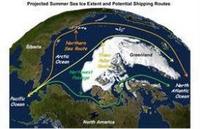-
World’s first zero emission sports car is built-at-home electric car

A new partnership has developed the world’s first build at home electric race car kit, an all-electric sports car designed and engineered to support a growing demand for zero emission racing vehicles. The iRacer kit, available from £13,999, can be transformed quickly between hybrid, pure electric, or internal combustion engines.
-
-
Enabling small ships to launch and retrieve long-endurance UAVs
About 98 percent of the world’s land area lies within 900 nautical miles of ocean coastlines. Enabling small ships to launch and retrieve long-endurance UAVs on demand would greatly expand the U.S. military’s situational awareness and ability quickly and flexibly to engage in hotspots over land or water. DARPA is seeking companies to develop these systems.
-
-
New ways to store data securely with untrusted cloud providers
Cloud storage security is an especially important issue for anyone dealing with large amounts of data that are supposed to be stored for a long period, such as archival and backup data. Researchers received a top honor for their ideas on better ways to ensure the integrity and long-term reliability of data stored at potentially untrusted cloud storage providers.
-
-
Global warming opening new shipping routes in Arctic Ocean

The Arctic Ocean has captured the imagination of explorers because of the possibility it offers for traveling between the Pacific and the Atlantic oceans through the Bering Strait. Until recently, however, sea ice has blocked access to the potential shortcut between Asia and North America or Europe. In the past two years, the ice has begun to melt in late summer to such an extent that even ordinary seagoing vessels have been able to enter its frigid waters. For vessels traveling between Rotterdam in the Netherlands and Yokohama, Japan, the Northern Sea Route is approximately 40 percent shorter than the traditional route through the Suez Canal.
-
-
Police budget cuts a boon to private security picks
In cities across the United State, local law enforcement, facing deep budget cuts, has had to do more police work with fewer officers. New Jersey alone lost 4,200 officers between 2008 and 2011. The reduction in police force has been a boon to the U.S. private security industry, which is expected to earn more than $19 billion by 2016.
-
-
RFI for cybersecurity framework for critical infrastructure
In his 12 February 2013 Executive Order, President Obama called for the development of a Cybersecurity Framework to reduce cyber risks to critical infrastructure such as power plants and financial, transportation, and communications systems. The National Institute of Standards and Technology (NIST) the other day issued a Request for Information (RFI) in the Federal Register as its first step in the process to developing that framework.
-
-
Developing the next-generation of VTOL aircraft

One of the greatest challenges of the past half century for aerodynamics engineers has been how to increase the top speeds of aircraft that take off and land vertically without compromising the aircraft’s lift to power in hover or its efficiency during long-range flight. DARPA’s new VTOL X-Plane project aims to achieve higher speeds, increased efficiency, and elegant design.
-
-
Saving money and time in developing phased RF arrays
Phased radio frequency (RF) arrays use numerous small antennas to steer RF beams without mechanical movement. These electronics are invaluable for critical DoD applications such as radar, communications, and electronic warfare. These arrays, however, come with a high price tag. Current phased arrays are extremely expensive and can take many years to engineer and build.
-
-
New power engineering curriculum to help U.S. security, economy
Nearly 40 percent of all energy consumed in the United States is first converted to electricity, with that figure expected to rise to as much as 70 percent in the future. Increasing the pipeline of graduates in electric power and energy has implications for both the country’s place in the global market and national defense. The more expertise there is at home, the less the United States will have to import talent and energy resources from overseas. An Office of Naval Research (ONR)-supported project is bringing sweeping changes to electric power and energy education at universities throughout the country, establishing first-time programs at some schools and bringing new courses and labs to others.
-
-
Modified bacteria turn bio waste into fat for fuel

“Green” chemistry developed at Rice University is at the center of a new government effort to turn plant waste into fatty acids and then into fuel. A new project aims to develop a new generation of renewable energy and bio-based products from switchgrass and forestry residues and from a new hybrid of sorghum.
-
-
Defense Department drops Blackberry
The U.S. Department of Defense has opened its mobile communication networks to Apple, Google, and other mobile communication companies.Currently the department handles more than 600,000 mobile devices, of which 470,000 are BlackBerrys, 41,000 are Apple devices, and 8,700 run on Google’s Android system.
-
-
iPhones can reveal a lot about their owners to law enforcement
People assume their iPhones are safe to keep their personal information on. They would be dismayed to realize what law enforcement agencies can find about them on their phone.
-
-
Water security experts at U Arizona annual conference
How can Arizona secure a safe, sustainable water supply for its current and future residents? The University of Arizona Water Resources Research Center will take on this complex issue at its annual conference on 5 March.
-
-
Much less additional land available for biofuel production
Amid efforts to expand production of biofuels, scientists are reporting new estimates that downgrade the amount of additional land available for growing fuel crops by almost 80 percent.
-
-
DHS awards contract for utility plant at the Kansas biolab
DHS has awarded a $40 million contract to build a utility plant at a $1.15 billion animal research lab in Kansas. The 87,000 square foot facility will replace an animal research lab on Plum Island in New York and will be used to research deadly animal diseases that affect livestock.
-
- All
- Regional
- Water
- Biometrics
- Borders/Immig
- Business
- Cybersecurity
- Detection
- Disasters
- Government
- Infrastructure
- International
- Public health
- Public Safety
- Communication interoperabillity
- Emergency services
- Emergency medical services
- Fire
- First response
- IEDs
- Law Enforcement
- Law Enforcement Technology
- Military technology
- Nonlethal weapons
- Nuclear weapons
- Personal protection equipment
- Police
- Notification /alert systems
- Situational awareness
- Weapons systems
- Sci-Tech
- Sector Reports
- Surveillance
- Transportation
Advertising & Marketing: advertise@newswirepubs.com
Editorial: editor@newswirepubs.com
General: info@newswirepubs.com
2010-2011 © News Wire Publications, LLC News Wire Publications, LLC
220 Old Country Road | Suite 200 | Mineola | New York | 11501
Permissions and Policies
Editorial: editor@newswirepubs.com
General: info@newswirepubs.com
2010-2011 © News Wire Publications, LLC News Wire Publications, LLC
220 Old Country Road | Suite 200 | Mineola | New York | 11501
Permissions and Policies
